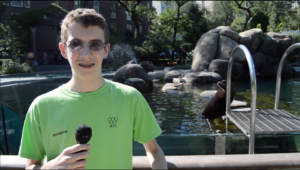Interviewing a Sea Lion

To view the photo-rich magazine version, click here.
Originally appears in the Winter 2018 issue.
Most teenagers are incredibly comfortable with using technology like YouTube, Facebook Live, and Snapchat to communicate. This comfort inspired me to focus on social media as a platform for youth empowerment in conservation. I developed a multidisciplinary lesson plan to engage teens actively with conservation in their local communities by making high-quality videos and distributing them via social media.
I work as a conservation educator at the Central Park Zoo in New York City, where I had the privilege of working with the participants of, and helping to develop a curriculum for, a three-week long teen summer camp. As part of the curriculum, I developed a lesson plan for a self-selected group of teens to meet for five hours a week to work on a video project. My group consisted of four teens, but the lesson plan is designed for a much larger class that can be split into smaller groups, each of which makes their own video. I asked my class to learn about an environmental issue affecting them, and to create a two minute-long video explaining the issue and presenting a solution or helpful action that an average person could take.
The curriculum purposely emphasizes a positive action point. Much of today’s conservation messaging is negative or apocalyptic, which can lead educators to shy away from tackling it in the classroom. Sticking to a positive message empowered my group of teens to take ownership of their issue, and it encouraged those who viewed the video to turn their empathy into action. My ultimate goal was that my teens would share their finished video with the wider world via the internet.
This content is restricted to subscribers only.
If you are not yet a subscriber, please consider taking out a subscription here.
If you are an existing subscriber, kindly log in or contact us at info@greenteacher.com for more information.










